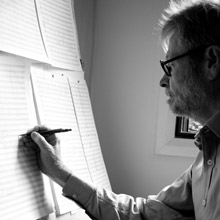New Piano Sonata
On May 9 2012 the distinguished Australian pianist Bernadette Harvey gave the brilliant premiere performance of Ross Edwards’ new Piano Sonata at a special concert in the Sydney Conservatorium’s Verbrugghen Hall. The Sonata, composed especially for Bernadette, was commissioned by Sydney University as part of the celebrations of the 100th anniversary of the Conservatorium.
The score of the Sonata is now available from The Australian Music Centre – Email: info@australianmusiccentre.com.au – Phone +61 2 9247 4677 – and the work has been recorded for future release by Tall Poppies Records.
Immediately after her concert performance Bernadette recorded the work for Youtube:
http://www.youtube.com/watch?v=Dgn-of7cTxE

Ross Edwards with Bernadette Harvey
“Bernadette Harvey demonstrated once again that she is one of Australia’s most enterprising and resourceful pianists. Gifted with a rare physical control of the instrument and intellectual and interpretative qualities to match, she took the audience on a journey across rarely encountered musical territory. I particularly admired the skill Harvey essayed with Ross Edwards’ Piano Sonata (2011). Whether in the elated, joyful measures of the first movement, the gently lulling, melancholy moments of the slow movement or the intricate, idiosyncratic finale, Harvey sounded at her authoritative best.” (Neville Cohn, The West Australian).
Ross has written the following note:
My Piano Sonata has three movements. The first, which uses some of the devices of the classical sonata-allegro, opens with pounding earth rhythms punctuated by joyful outbursts that sound like birdsong. The jagged shapes and pulses of this material persist throughout much of the movement in various guises, sometimes directly re-stated, sometimes modified, transformed or merely hinted at. A delicately textured pentatonic episode provides a central moment of inward reflection, characteristic of my music, but in this case perhaps unconsciously influenced by the wind chimes in my neighbour’s garden.
As slow and sad as anything I’ve composed, the second movement – a simple three-part song form – flares briefly, and with a force that took me by surprise, into the Sancte Spiritus from my Dawn Mantras (which also marks the climax of my Third Symphony) before resuming its song of heartbreak. The last movement, I decided, needed to be cheerful. On a whim, I began by quoting one of my own children’s pieces, the last of the Five Little Piano Pieces, composed thirty five years earlier in 1976. Piano teachers, my wife among them, have long reprimanded me for making this piece too hard for little fingers and it seemed fitting that I should now further elevate it into the realm of virtuosity by increasing the tempo. Composed in the Indonesian pelog nem scale, its heterophonic interplay of voices suggests a toy gamelan playing with impossible velocity. Its child-like optimism shines through, however, and I tried to sustain this in later sections by preserving its spirit and momentum and echoing some of its rhythms. Following a wild introductory birdcall, textures recalling the playful Bach of the Two-Part Inventions are immediately established: Western polyphony here supplants South East Asian heterophony but a common musical purport creates a link between the cultures – or at least it does for me. The children’s music theme is reinforced by a fleeting but obvious Bach allusion.


